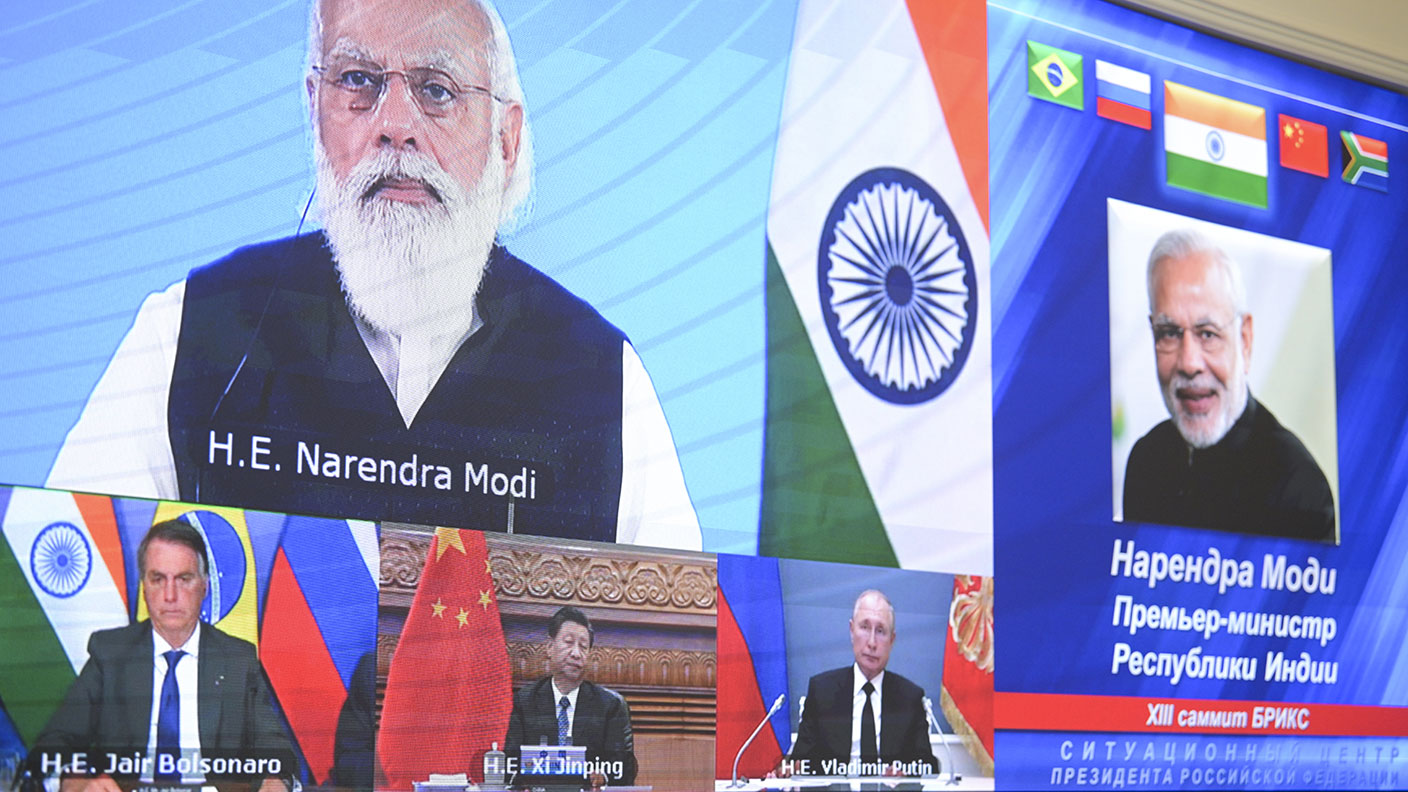Emerging markets: has the Brics dream survived reality?
Two decades ago the “Brics” – Brazil, Russia, India and China – were the global economy's rising stars, with expectations high for their rapid development. Max King looks at how things have panned out.

(John here – just a reminder to sign up for this month’s webinar, where I’ll be talking to Roland Arnold, manager of the popular BlackRock Smaller Companies investment trust, all about his views on prospects for Britain’s smaller companies. Make sure you don’t miss it – register here now. It’s entirely free and you can catch up later if you can’t join on the day, but do be sure to register.)
It is 20 years since Jim, now Lord, O’Neill coined the Bric acronym to cover the four most significant emerging economies: Brazil, Russia, India and China.
There followed a series of research reports from his team at Goldman Sachs projecting how these economies would develop over the following 50 years and their impact on global financial markets.
MoneyWeek
Subscribe to MoneyWeek today and get your first six magazine issues absolutely FREE

Sign up to Money Morning
Don't miss the latest investment and personal finances news, market analysis, plus money-saving tips with our free twice-daily newsletter
Don't miss the latest investment and personal finances news, market analysis, plus money-saving tips with our free twice-daily newsletter
Twenty years on, how has it worked out?
Great expectations – but how have they panned out?
In 2003, the concept that spawned the “Brics” was extended to include South Africa, and in 2005 to cover “the next 11”: Bangladesh, Egypt, Indonesia, Iran, Korea, Mexico, Nigeria, Pakistan, Philippines, Turkey and Vietnam.
The purpose was to show the growing importance of the emerging world to the global economy and the implications for inter-governmental institutions and investors. Goldman Sachs made no assumptions about political systems, but did set out “the conditions for growth.”
These were “macro-stability,” notably low inflation; “institutions”, such as the legal system, functioning markets, health and education systems, financial institutions and government bureaucracy; “openness” in trade and foreign direct investment; and “education” to provide skilled workers.
Implicit in all this were the universally-accepted assumptions of continuing globalisation, the liberal economic order, and that the first priority of governments was national prosperity as the prerequisite of all other objectives.
All this was expected to lead down the democratic path.
So looking back now, 20 years on, how has it worked out?
In 2000, the Brics accounted for 8% of world GDP at then-current prices and 23.3% at purchasing power parity (PPP), which adjusts for lower prices in those countries. This was expected to rise to 47% and 52% in 2050, by which time exchange rates would broadly reflect purchasing power.
In other words, Bric currencies would appreciate against the dollar by about 2.5% a year. As a result, in 2020, Brics would account for 22% of the world economy in dollars and 41% at PPP.
Goldman Sachs estimated annual growth in Brazil at 3.6%, with its economy overtaking that of Italy by 2025; France by 2031; and the UK and Germany by 2036. China’s growth rate was expected to fall from 8% in 2003 to 5% in 2020 and 3.5% by the mid-2040s, while India’s growth rate was expected to slow, but remain above 5%.
Russia would be hampered by a shrinking population but still overtake Italy in 2018, France in 2024, the UK in 2027 and Germany in 2028. By 2050, Russia’s GDP per capita would be by far the highest of the Brics.
These forecasts of higher growth than in the OECD reflected three factors: a “catch-up” as the Brics adopted the technologies of developed economies; high rates of investment, driven by the opportunities growth offered and increased capital per worker; and demographics, the consequences of population growth for the workforce and consumption.
About a third of the increase in dollar GDP would be accounted for by currency appreciation.
Not all the forecasts look too bad – but the markets have been disappointing
At first sight, Goldman Sachs looks on course. The Brics now account for 24.3% of global GDP in dollars and 31.4% at PPP, according to IMF data.
The detail, however, is far from that expected.
China’s share of world GDP has risen from 3.6% in dollars and 12.6% at PPP in 2000 to 17.7% and 18.8%. This is actually ahead of Goldman Sachs forecasts, particularly in PPP terms, due to 50 years of expected currency appreciation taking place in 20.
India’s share has risen from 1.6% in dollars and 5% at PPP to 3.25% and 7.2%. This is broadly in-line with Goldman Sachs expectations, helped by population growth, though GDP per head is less than a fifth of China’s or Russia’s.
Russia’s share has risen from 0.6% in dollars and 2.7% at PPP, to 1.8% and 3.1%, well behind Goldman Sachs expectation. Meanwhile Brazil’s share has actually fallen from 2% in dollars and 2.9% at PPP to 1.6% and 2.3%.
Both Brazil and Russia are well short of overtaking Italy, and Russia’s GDP per head, at $11,650, has fallen behind China’s. There has been some narrowing in the gap between dollar and PPP GDP for India and Russia but little for Brazil, indicating that currencies have not appreciated as Goldman Sachs expected.
This suggests that the Chinese stockmarket should have exceeded expectations – but Brazil and Russia lagged, especially in dollar terms. Goldman Sachs warned in 2005 that “local markets may not be the best vehicle for the local growth story” but the evidence for this at the time came from China which had seen “lacklustre performance.”
Still, “within a decade Bric’s market capitalisation could be four times bigger than today” while “Brics’ share in a benchmarked global portfolio would rise, perhaps to as much as 17%.”
In reality, Brics have fallen well short. The MSCI All Countries World index has 2,964 constituents with a combined market value of $68.4trn – this covers 85% of global investable equities, in 23 developed and 27 emerging markets.
Emerging markets account for just 11.6% of the total, and Brics for a little over half of that. China is around 4%, India below 1.5% and Brazil and Russia each a little over 0.5%.
South Korea (in the Goldman Sachs Next 11) is 1.5% of the MSCI index and Taiwan 1.7%. Taiwan was not in the Next 11; perhaps Goldman Sachs assumed that it would be absorbed by China.
Taiwan and South Korea, though, should surely be categorised as developed economies alongside Singapore and Hong Kong.
Is it all bad news?
So true emerging markets have lagged Goldman Sachs’ expectations by a long way. Even China, with the economy struggling and its stockmarket down 30% from its January high, may be going off the rails.
The Brazilian and Russian economies are based on commodities, and Goldman Sachs disregarded the “resources curse” – the fact that it is human capital, not wealth of natural resources, that makes a country prosper, and that abundant natural resources actually hinder human capital-based development.
But in 2000-2005, perhaps we all believed that “this time, it will be different.”
That the economic development of the Brics has fallen short of the Goldman Sachs projections and their stockmarkets far short, should not reflect on the quality or value of the research. It is only 2021. There is a long way to go before 2050; the Brics and emerging markets in general could get back on track after a disappointing few years.
The team at Goldman Sachs were extremely wary of translating economic forecasts into market projections. The currency appreciation implied by PPP convergence with dollar GDP was not a key part of the research, which contains many insights and much valuable analysis about the factors driving growth.
Finally, Goldman Sachs provided a valuable benchmark against which to judge Brics progress. So far, it has been disappointing and it is easy to assume that the outlook for economic and market development will continue to deteriorate – but it may not.
That will be the subject of part two.
Get the latest financial news, insights and expert analysis from our award-winning MoneyWeek team, to help you understand what really matters when it comes to your finances.

Max has an Economics degree from the University of Cambridge and is a chartered accountant. He worked at Investec Asset Management for 12 years, managing multi-asset funds investing in internally and externally managed funds, including investment trusts. This included a fund of investment trusts which grew to £120m+. Max has managed ten investment trusts (winning many awards) and sat on the boards of three trusts – two directorships are still active.
After 39 years in financial services, including 30 as a professional fund manager, Max took semi-retirement in 2017. Max has been a MoneyWeek columnist since 2016 writing about investment funds and more generally on markets online, plus occasional opinion pieces. He also writes for the Investment Trust Handbook each year and has contributed to The Daily Telegraph and other publications. See here for details of current investments held by Max.
-
 Leaving it too late to gift inheritances costs some of Britain’s wealthiest families £3m each
Leaving it too late to gift inheritances costs some of Britain’s wealthiest families £3m eachEven average Brits are being landed with huge and unexpected inheritance tax bills because of a little understood rule around gifting, new figures show
-
 The best and worst performing UK stocks of 2025 as FTSE 100 approaches record year
The best and worst performing UK stocks of 2025 as FTSE 100 approaches record yearThe blue-chip index is heading for another top year despite investors steering clear of UK equity funds
-
 Halifax: House price slump continues as prices slide for the sixth consecutive month
Halifax: House price slump continues as prices slide for the sixth consecutive monthUK house prices fell again in September as buyers returned, but the slowdown was not as fast as anticipated, latest Halifax data shows. Where are house prices falling the most?
-
 Rents hit a record high - but is the opportunity for buy-to-let investors still strong?
Rents hit a record high - but is the opportunity for buy-to-let investors still strong?UK rent prices have hit a record high with the average hitting over £1,200 a month says Rightmove. Are there still opportunities in buy-to-let?
-
 Pension savers turn to gold investments
Pension savers turn to gold investmentsInvestors are racing to buy gold to protect their pensions from a stock market correction and high inflation, experts say
-
 Where to find the best returns from student accommodation
Where to find the best returns from student accommodationStudent accommodation can be a lucrative investment if you know where to look.
-
 The world’s best bargain stocks
The world’s best bargain stocksSearching for bargain stocks with Alec Cutler of the Orbis Global Balanced Fund, who tells Andrew Van Sickle which sectors are being overlooked.
-
 Revealed: the cheapest cities to own a home in Britain
Revealed: the cheapest cities to own a home in BritainNew research reveals the cheapest cities to own a home, taking account of mortgage payments, utility bills and council tax
-
 UK recession: How to protect your portfolio
UK recession: How to protect your portfolioAs the UK recession is confirmed, we look at ways to protect your wealth.
-
 Buy-to-let returns fall 59% amid higher mortgage rates
Buy-to-let returns fall 59% amid higher mortgage ratesBuy-to-let returns are slumping as the cost of borrowing spirals.
